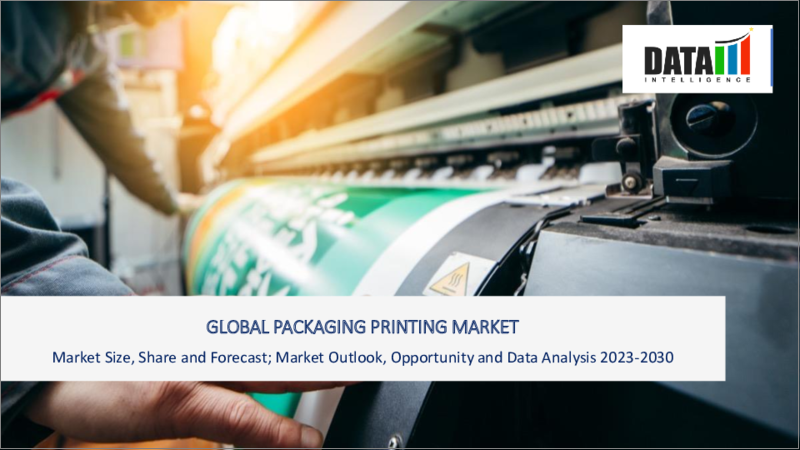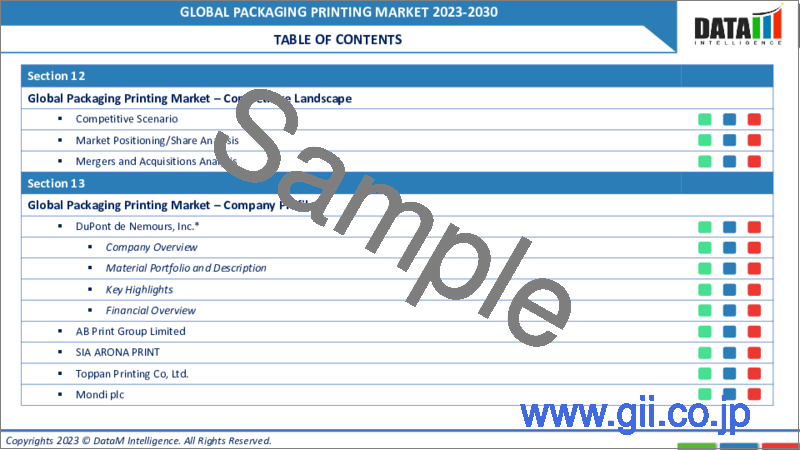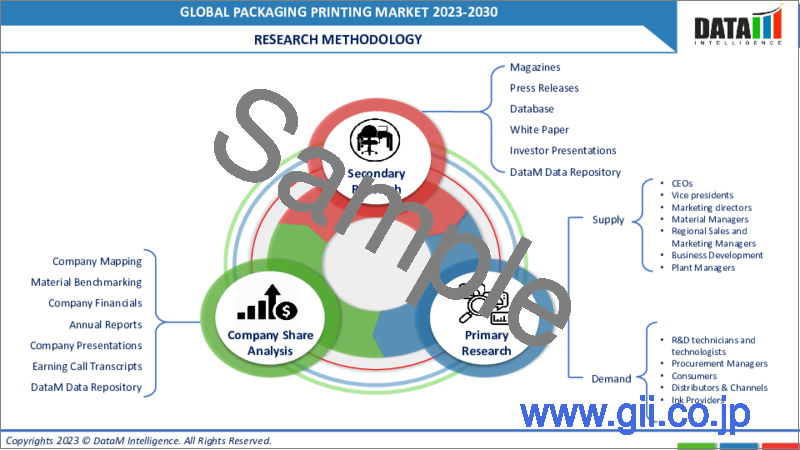|
|
市場調査レポート
商品コード
1304553
パッケージ印刷の世界市場-2023年~2030年Global Packaging Printing Market - 2023-2030 |
||||||
カスタマイズ可能
適宜更新あり
|
|||||||
| パッケージ印刷の世界市場-2023年~2030年 |
|
出版日: 2023年07月07日
発行: DataM Intelligence
ページ情報: 英文 189 Pages
納期: 即日から翌営業日
|
- 全表示
- 概要
- 目次
市場概要
世界のパッケージ印刷市場は、2022年には米国で3,671億米ドルに達し、2030年には5,070億米ドルに達すると予測され、予測期間2023-2030年のCAGRは4.3%で成長する見込みです。
世界のパッケージ印刷市場は、近年著しい成長と変貌を遂げており、ブランディング、製品識別、消費者参加において重要な役割を果たしています。フレキソ印刷、リソグラフィ、グラビア印刷、デジタル印刷、スクリーン印刷など多様な印刷技術が含まれ、さまざまな産業で視覚に訴える情報満載のパッケージを生み出しています。
世界のパッケージ印刷市場は、主に消費者需要の増加、製品革新、進化する市場力学に後押しされ、市場動向の面で着実な拡大を経験しています。
ユニークでパーソナライズされた体験に対する嗜好の高まりに後押しされ、パッケージ印刷業界はカスタマイズへとシフトしています。デジタル印刷技術は、ブランドによってパーソナライズされたパッケージを作成するために活用されており、ターゲットを絞ったマーケティング、顧客エンゲージメントの強化、ブランド・ロイヤルティの育成を可能にしています。
アジア太平洋地域は、世界のパッケージ印刷市場において最も急成長している地域のひとつであり、市場シェアの4分の1以上を占めています。これは、人口が多く、eコマースセクターが盛んなためです。また、フレキソ印刷は世界のパッケージ印刷市場の約4分の1のシェアを占め、支配的な地位を占めています。
市場力学
eコマースの拡大と持続可能なパッケージへの取り組み
環境意識の高まりと規制強化により、企業は持続可能なパッケージソリューションを採用するようになっています。パッケージ印刷は、環境に優しい材料の使用を可能にし、持続可能な実践の実施をサポートするため、この移行において重要な役割を果たしています。欧州連合(EU)の包装廃棄物指令は、2030年までにEU市場のすべての包装を再利用またはリサイクル可能にすることを目指しています。各指令は、世界の同様の取り組みとともに、持続可能な包装に対する需要の急増につながっています。
さらに、eコマースの急成長は包装印刷市場に大きな影響を与えています。オンライン小売プラットフォームが増加し、オンラインで商品を購入する傾向が高まっているため、効率的なパッケージ・ソリューションに対する需要が急増しています。eコマース企業は、出荷時に製品を保護する視覚的に魅力的なパッケージデザインを必要としています。eコマース部門が活況を呈する中、政府は拡大生産者責任プログラムなどの政策を通じて持続可能な実践を積極的に推進し、メーカーに環境に優しいパッケージ・ソリューションの採用を促しています。
世界化と国際貿易別ブランド差別化と製品プロモーション
国際貿易の拡大とグローバリゼーションは、パッケージ印刷の需要増加につながっています。企業が新たな市場に事業を拡大するにつれ、さまざまな地域特有の要件を満たす効率的なパッケージ・ソリューションが必要とされています。それぞれの事実が、包装印刷会社が多国籍企業の多様な包装ニーズに応える機会を生み出しています。世界貿易機関の報告によると、2021年の商品輸出は前年比5.3%増となり、世界貿易の継続的な拡大を反映しています。
パッケージ印刷は、企業にブランドを差別化し、製品プロモーションを強化する機会を提供します。業界を超えた競争が激化する中、企業は消費者の目を引き、ブランド価値を効果的に伝えるユニークなパッケージデザインの作成に注力しています。オーストラリア政府の産業・科学・エネルギー・資源省によると、パッケージは消費者の購買決定に影響を与える可能性があり、93%の消費者がパッケージデザインを購買選択の重要な要素として考えています。
環境規制と持続可能性への懸念
世界のパッケージ印刷市場は、様々な業界における革新的なパッケージ・ソリューションに対する需要の高まりに牽引され、長年にわたって大きな成長を遂げてきました。しかし、その成長軌道にもかかわらず、この業界に課題がないわけではないです。包装印刷市場における重大な抑制要因の1つは、環境規制と持続可能性への懸念への注目が高まっていることです。世界各国の政府は、包装廃棄物を最小限に抑え、環境に優しい慣行を奨励するため、より厳しい規制を制定しています。
例えば、欧州連合(EU)の単一使用プラスチック指令は、2021年までにいくつかの単一使用プラスチック品目を禁止することを目標としており、持続可能な代替包装へのシフトにつながっています。こうした規制はメーカーに追加コストを課し、包装の選択や印刷工程に影響を与えます。さらに、欧州委員会によると、2018年のEUにおけるプラスチック廃棄物総量の40%をプラスチック包装廃棄物の発生が占めており、環境問題への対応が急務であることが強調されています。このように、持続可能性への懸念に対処し、より厳しい規制を実施するための政府の取り組みは、包装の選択と印刷工程に影響を与えます。このような制約にもかかわらず、業界関係者は、持続可能で技術主導のパッケージ環境の進化する需要に対応するために適応し、革新しなければならないです。
COVID-19影響分析
世界の包装印刷市場は、COVID-19の流行により大きな混乱を経験しました。サプライチェーンの混乱、消費者行動のシフト、デジタルトランスフォーメーションの必要性は、業界が直面した主要な課題でした。しかし、政府の支援策やイニシアチブは、業界の適応力と相まって、市場の安定化に重要な役割を果たしました。世界各国の政府は、包装印刷業界を含む企業へのCOVID-19の影響を緩和するために、さまざまな支援策やイニシアチブを実施しました。
例えば、いくつかの政府は金融支援、税制優遇措置、低利融資を提供し、事業の持続と危機からの回復を支援しました。同様に、2021年4月、産業貿易省は持続可能なパッケージ・ソリューションを促進するための新しいプログラムを発表しました。このプログラムは、包装印刷会社が環境に優しい慣行や材料を採用することを奨励し、環境に優しい包装に対する需要の増加に対応しつつ、環境の持続可能性に貢献することを目的としていました。このようなイニシアチブは、包装印刷市場を安定させ、業界関係者を支援する上で重要な役割を果たしました。世界がパンデミックから徐々に回復する中、包装印刷業界は進化を続け、COVID-19後の世界の変化する需要に対応するため、持続可能性、革新、デジタル技術を受け入れています。
目次
第1章 調査手法と調査範囲
第2章 定義と概要
第3章 エグゼクティブサマリー
第4章 市場力学
- 影響要因
- 促進要因
- eコマース活動の活発化と消費者意識の高まり
- 技術の進歩とブランド・マーケティング戦略
- eコマースの拡大と持続可能な包装への取り組み
- 世界化と国際貿易に伴うブランドの差別化と製品プロモーション
- 抑制要因
- 環境規制と持続可能性への懸念
- 原材料価格の変動
- 機会
- 影響分析
- 促進要因
第5章 業界分析
- ポーターのファイブフォース分析
- サプライチェーン分析
- 価格分析
- 規制分析
第6章 COVID-19分析
第7章 印刷技術別
- フレキソ印刷
- グラビア
- デジタル
- その他
第8章 素材別
- プラスチック
- 紙・板紙
- その他
第9章 インク別
- 溶剤系インク
- UV硬化型インク
- 水性インク
第10章 用途別
- 飲食品
- 化粧品
- 医薬品
- その他
第11章 地域別
- 北米
- 米国
- カナダ
- メキシコ
- 欧州
- ドイツ
- 英国
- フランス
- イタリア
- ロシア
- その他欧州
- 南米
- ブラジル
- アルゼンチン
- その他南米
- アジア太平洋
- 中国
- インド
- 日本
- オーストラリア
- その他アジア太平洋地域
- 中東・アフリカ
第12章 競合情勢
- 競合シナリオ
- 市況/シェア分析
- M&A分析
第13章 企業プロファイル
- DuPont.
- 会社概要
- 製品ポートフォリオと説明
- 財務概要
- 最近の動向
- AB Print Group Limited
- ARONA PRINT
- Toppan Printing Co, Ltd.
- Mondi plc
- HP Inc.
- Crown Holdings, Inc.,
- Quantum Print and Packaging Ltd
- Paramount Packaging Ltd.
- Canon, Inc.
第14章 付録
Market Overview
The Global Packaging Printing Market reached US$ 367.1 billion in 2022 and is expected to reach US$ 507.0 billion by 2030, growing with a CAGR of 4.3% during the forecast period 2023-2030.
The Global Package Printing Market has undergone notable growth and transformation in recent years, playing a vital role in branding, product identification, and consumer engagement. It encompasses a diverse range of printing techniques such as flexography, lithography, gravure, digital printing, and screen printing to create visually appealing and informative packaging across various industries.
The global packaging printing market has experienced steady expansion in terms of market trend, primarily fueled by increasing consumer demand, product innovation, and evolving market dynamics.
Driven by the growing preference for unique and personalized experiences, the package printing industry is shifting towards customization. Digital printing technology is being leveraged by brands to create personalized packaging, enabling targeted marketing, enhanced customer engagement, and fostering brand loyalty.
The Asia-Pacific region stands out as one of the fastest-growing regions in the global packaging printing market, accounting for more than a quarter of the market share. The respective fact can be attributed to its large population base and the flourishing e-commerce sector. Additionally, the flexography packaging printing segment holds a dominant position, commanding approximately one-fourth of the market share in the global package printing market.
Market Dynamics
E-commerce Expansion and Sustainable Packaging Initiatives
Growing environmental consciousness and stricter regulations have prompted businesses to adopt sustainable packaging solutions. Package printing plays a crucial role in this transition, as it enables the use of eco-friendly materials and supports the implementation of sustainable practices. The European Union's Packaging Waste Directive aims to ensure that all packaging in the EU market is reusable or recyclable by 2030. The respective directive, along with similar initiatives worldwide, has led to a surge in demand for sustainable packaging.
Further, the rapid growth of e-commerce has had a profound impact on the packaging printing market. With the increasing number of online retail platforms and the rising trend of purchasing goods online, the demand for efficient packaging solutions has surged. E-commerce companies require visually appealing packaging designs that protect the products during shipping. As e-commerce sector is booming, governments are actively promoting sustainable practices through policies, such as extended producer responsibility programs, encouraging manufacturers to adopt eco-friendly packaging solutions.
Brand Differentiation and Product Promotion Combined with Globalization and International Trade
The growth of international trade and globalization has led to an increase in the demand for packaging printing. As businesses expand their operations to new markets, they require efficient packaging solutions to meet the specific requirements of different regions. The respective fact has created opportunities for packaging printing companies to cater to the diverse packaging needs of multinational corporations. The World Trade Organization reports that merchandise exports grew by 5.3% in 2021 compared to the previous year, reflecting the continued expansion of global trade.
Package printing offers businesses an opportunity to differentiate their brands and enhance product promotion. With increasing competition across industries, companies are focusing on creating unique packaging designs that catch consumers' attention and communicate brand values effectively. According to the Australian Government's Department of Industry, Science, Energy, and Resources, packaging can influence consumer purchasing decisions, with 93% of consumers considering packaging design as an important factor in their purchasing choices.
Environmental Regulations and Sustainability Concerns
The global packaging printing market has witnessed significant growth over the years, driven by the increasing demand for innovative packaging solutions across various industries. However, despite its positive trajectory, the industry is not without its challenges. One of the significant restraints in the packaging printing market is the increasing focus on environmental regulations and sustainability concerns. Governments worldwide are enacting stricter regulations to minimize packaging waste and encourage eco-friendly practices.
For instance, the European Union's Single-Use Plastics Directive aims to ban several single-use plastic items by 2021, leading to a shift towards sustainable packaging alternatives. Such regulations impose additional costs on manufacturers, impacting their packaging choices and printing processes. Further, according to the European Commission, plastic packaging waste generation accounted for 40% of total plastic waste in the EU in 2018, emphasizing the urgency to address environmental concerns. Thus, government efforts to address sustainability concerns and enforce stricter regulations impact packaging choices and printing processes. Despite these restraints, industry stakeholders must adapt and innovate to meet the evolving demands of a sustainable and technologically-driven packaging landscape.
COVID-19 Impact Analysis
The global packaging printing market experienced significant disruptions due to the COVID-19 pandemic. Supply chain disruptions, shifts in consumer behavior, and the need for digital transformation were key challenges faced by the industry. However, government support measures and initiatives, coupled with industry adaptability, played a crucial role in stabilizing the market. Governments around the globe implemented various support measures and initiatives to mitigate the impact of COVID-19 on businesses, including those in the packaging printing industry.
For instance, several governments offered financial aid, tax incentives, and low-interest loans to help businesses sustain operations and recover from the crisis. Similarly, in April 2021, the Ministry of Industry and Trade announced a new program to promote sustainable packaging solutions. The program aimed to encourage packaging printing companies to adopt eco-friendly practices and materials, contributing to environmental sustainability while meeting increased demand for green packaging. Such initiatives played a vital role in stabilizing the packaging printing market and supporting industry players. As the world gradually recovers from the pandemic, the packaging printing industry continues to evolve, embracing sustainability, innovation, and digital technologies to meet the changing demands of a post-COVID-19 world.
Segment Analysis
The Global Packaging Printing Market is segmented based on printing technology, material, ink, application and region.
Growing Demand for Sustainable Packaging Solutions and Significant Advancements in Technology
The flexible packaging segment has been a major driving force behind this growth, with flexography being the preferred choice for printing on materials such as films, pouches, and labels. The rise of flexography can be attributed, in part, to the growing demand for sustainable packaging solutions. With increasing environmental concerns, consumers and businesses alike are actively seeking eco-friendly alternatives. Flexography aligns with this trend by utilizing water-based inks and offering energy-efficient printing processes.
The governments of several countries have recognized the environmental benefits of flexography and have encouraged its adoption through favorable policies and incentives. Government-funded projects have facilitated the integration of digital technologies with flexographic printing, enabling personalized packaging solutions and shorter print runs.
Thus, it can be concluded that the global packaging printing market has witnessed a remarkable growth of flexography due to its unmatched advantages, increasing demand for sustainable packaging, and significant advancements in technology. As flexographic printing continues to evolve, it is poised to play a pivotal role in shaping the future of packaging printing, meeting the ever-changing needs of consumers and businesses globally.
Geographical Analysis
Government-Led Initiatives and Investments in Research and Development
Asia-Pacific's global packaging printing market growth is fueled by its manufacturing prowess, technological advancements, and expanding consumer base. Government-led initiatives and investments in research and development have further enhanced the region's competitiveness in the industry. For instance, India has emerged as a promising market for packaging printing. The Indian Printing Packaging & Allied Machinery Manufacturers' Association reported a 15% growth in the packaging industry in India during 2020-2021, reflecting the country's rising demand for packaged products.
Similarly, the Singapore government, known for its focus on innovation and technology, launched a smart packaging solution in 2022. The solution incorporates RFID technology, enabling real-time tracking and monitoring of packages. Such developments showcases Asia-Pacific's commitment to technological advancements in the packaging industry. With China's significant market share and emerging markets like India, Asia-Pacific is poised to continue its upward trajectory in the global packaging printing market.
Competitive Landscape
DuPont., AB Print Group Limited, ARONA PRINT, Toppan Printing Co, Ltd., Mondi plc, HP Inc., Crown Holdings, Inc.,Quantum Print and Packaging Ltd, Paramount Packaging Ltd. and Canon, Inc.
Why Purchase the Report?
- To visualize the Global Packaging Printing Market segmentation based on printing technology, material, ink, application and region, as well as understand key commercial assets and players.
- Identify commercial opportunities by analyzing trends and co-development.
- Excel data sheet with numerous data points of packaging printing market-level with all segments.
- PDF report consists of a comprehensive analysis after exhaustive qualitative interviews and an in-depth study.
- Product mapping available as Excel consisting of key products of all the major players.
The Global Packaging Printing Market Report Would Provide Approximately 69 Tables, 70 Figures And 189 Pages.
Target Audience 2023
- Manufacturers/ Buyers
- Industry Investors/Investment Bankers
- Research Professionals
- Emerging Companies
Table of Contents
1. Methodology and Scope
- 1.1. Research Methodology
- 1.2. Research Objective and Scope of the Report
2. Definition and Overview
3. Executive Summary
- 3.1. Snippet by Printing Technology
- 3.2. Snippet by Material
- 3.3. Snippet by Ink
- 3.4. Snippet by Application
- 3.5. Snippet by Region
4. Dynamics
- 4.1. Impacting Factors
- 4.1.1. Drivers
- 4.1.1.1. Increasing E-commerce Activities and Growing Consumer Awareness
- 4.1.1.2. Technological Advancements and Branding and Marketing Strategies
- 4.1.1.3. E-commerce Expansion and Sustainable Packaging Initiatives
- 4.1.1.4. Brand Differentiation and Product Promotion Combined with Globalization and International Trade
- 4.1.2. Restraints
- 4.1.2.1. Environmental Regulations and Sustainability Concerns
- 4.1.2.2. Volatility in Raw Material Prices
- 4.1.3. Opportunity
- 4.1.4. Impact Analysis
- 4.1.1. Drivers
5. Industry Analysis
- 5.1. Porter's Five Force Analysis
- 5.2. Supply Chain Analysis
- 5.3. Pricing Analysis
- 5.4. Regulatory Analysis
6. COVID-19 Analysis
- 6.1. Analysis of COVID-19
- 6.1.1. Scenario Before COVID
- 6.1.2. Scenario During COVID
- 6.1.3. Scenario Post COVID
- 6.2. Pricing Dynamics Amid COVID-19
- 6.3. Demand-Supply Spectrum
- 6.4. Government Initiatives Related to the Market During Pandemic
- 6.5. Manufacturers Strategic Initiatives
- 6.6. Conclusion
7. By Printing Technology
- 7.1. Introduction
- 7.1.1. Market Size Analysis and Y-o-Y Growth Analysis (%), By Printing Technology
- 7.1.2. Market Attractiveness Index, By Printing Technology
- 7.2. Flexography*
- 7.2.1. Introduction
- 7.2.2. Market Size Analysis and Y-o-Y Growth Analysis (%)
- 7.3. Gravure
- 7.4. Digital
- 7.5. Others
8. By Material
- 8.1. Introduction
- 8.1.1. Market Size Analysis and Y-o-Y Growth Analysis (%), By Material
- 8.1.2. Market Attractiveness Index, By Material
- 8.2. Plastic*
- 8.2.1. Introduction
- 8.2.2. Market Size Analysis and Y-o-Y Growth Analysis (%)
- 8.3. Paper & Paperboard
- 8.4. Others
9. By Ink
- 9.1. Introduction
- 9.1.1. Market Size Analysis and Y-o-Y Growth Analysis (%), By Ink
- 9.1.2. Market Attractiveness Index, By Ink
- 9.2. Solvent-based Ink*
- 9.2.1. Introduction
- 9.2.2. Market Size Analysis and Y-o-Y Growth Analysis (%)
- 9.3. UV-curable Ink
- 9.4. Aqueous Ink
10. By Application
- 10.1. Introduction
- 10.1.1. Market Size Analysis and Y-o-Y Growth Analysis (%), By Application
- 10.1.2. Market Attractiveness Index, By Application
- 10.2. Food & Beverage*
- 10.2.1. Introduction
- 10.2.2. Market Size Analysis and Y-o-Y Growth Analysis (%)
- 10.3. Cosmetics
- 10.4. Pharmaceutical
- 10.5. Others
11. By Region
- 11.1. Introduction
- 11.1.1. Market Size Analysis and Y-o-Y Growth Analysis (%), By Region
- 11.1.2. Market Attractiveness Index, By Region
- 11.2. North America
- 11.2.1. Introduction
- 11.2.2. Key Region-Specific Dynamics
- 11.2.3. Market Size Analysis and Y-o-Y Growth Analysis (%), By Printing Technology
- 11.2.4. Market Size Analysis and Y-o-Y Growth Analysis (%), By Material
- 11.2.5. Market Size Analysis and Y-o-Y Growth Analysis (%), By Ink
- 11.2.6. Market Size Analysis and Y-o-Y Growth Analysis (%), By Application
- 11.2.7. Market Size Analysis and Y-o-Y Growth Analysis (%), By Country
- 11.2.7.1. The U.S.
- 11.2.7.2. Canada
- 11.2.7.3. Mexico
- 11.3. Europe
- 11.3.1. Introduction
- 11.3.2. Key Region-Specific Dynamics
- 11.3.3. Market Size Analysis and Y-o-Y Growth Analysis (%), By Printing Technology
- 11.3.4. Market Size Analysis and Y-o-Y Growth Analysis (%), By Material
- 11.3.5. Market Size Analysis and Y-o-Y Growth Analysis (%), By Ink
- 11.3.6. Market Size Analysis and Y-o-Y Growth Analysis (%), By Application
- 11.3.7. Market Size Analysis and Y-o-Y Growth Analysis (%), By Country
- 11.3.7.1. Germany
- 11.3.7.2. The UK
- 11.3.7.3. France
- 11.3.7.4. Italy
- 11.3.7.5. Russia
- 11.3.7.6. Rest of Europe
- 11.4. South America
- 11.4.1. Introduction
- 11.4.2. Key Region-Specific Dynamics
- 11.4.3. Market Size Analysis and Y-o-Y Growth Analysis (%), By Printing Technology
- 11.4.4. Market Size Analysis and Y-o-Y Growth Analysis (%), By Material
- 11.4.5. Market Size Analysis and Y-o-Y Growth Analysis (%), By Ink
- 11.4.6. Market Size Analysis and Y-o-Y Growth Analysis (%), By Application
- 11.4.7. Market Size Analysis and Y-o-Y Growth Analysis (%), By Country
- 11.4.7.1. Brazil
- 11.4.7.2. Argentina
- 11.4.7.3. Rest of South America
- 11.5. Asia-Pacific
- 11.5.1. Introduction
- 11.5.2. Key Region-Specific Dynamics
- 11.5.3. Market Size Analysis and Y-o-Y Growth Analysis (%), By Printing Technology
- 11.5.4. Market Size Analysis and Y-o-Y Growth Analysis (%), By Material
- 11.5.5. Market Size Analysis and Y-o-Y Growth Analysis (%), By Ink
- 11.5.6. Market Size Analysis and Y-o-Y Growth Analysis (%), By Application
- 11.5.7. Market Size Analysis and Y-o-Y Growth Analysis (%), By Country
- 11.5.7.1. China
- 11.5.7.2. India
- 11.5.7.3. Japan
- 11.5.7.4. Australia
- 11.5.7.5. Rest of Asia-Pacific
- 11.6. Middle East and Africa
- 11.6.1. Introduction
- 11.6.2. Key Region-Specific Dynamics
- 11.6.3. Market Size Analysis and Y-o-Y Growth Analysis (%), By Printing Technology
- 11.6.4. Market Size Analysis and Y-o-Y Growth Analysis (%), By Material
- 11.6.5. Market Size Analysis and Y-o-Y Growth Analysis (%), By Ink
- 11.6.6. Market Size Analysis and Y-o-Y Growth Analysis (%), By Application
12. Competitive Landscape
- 12.1. Competitive Scenario
- 12.2. Market Positioning/Share Analysis
- 12.3. Mergers and Acquisitions Analysis
13. Company Profiles
- 13.1. DuPont.*
- 13.1.1. Company Overview
- 13.1.2. Product Portfolio and Description
- 13.1.3. Financial Overview
- 13.1.4. Recent Developments
- 13.2. AB Print Group Limited
- 13.3. ARONA PRINT
- 13.4. Toppan Printing Co, Ltd.
- 13.5. Mondi plc
- 13.6. HP Inc.
- 13.7. Crown Holdings, Inc.,
- 13.8. Quantum Print and Packaging Ltd
- 13.9. Paramount Packaging Ltd.
- 13.10. Canon, Inc.
LIST NOT EXHAUSTIVE
14. Appendix
- 14.1. About Us and Services
- 14.2. Contact Us






